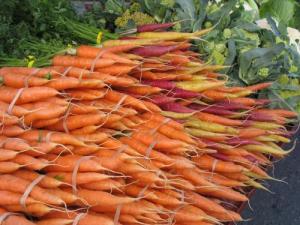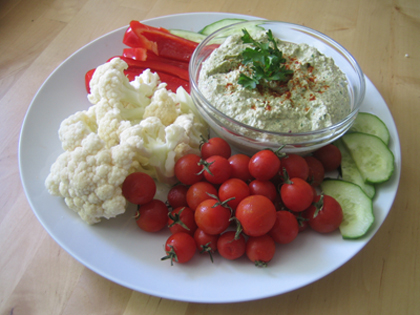Natural Organic Food
Consuming natural organic food is incredibly important, but the reason why isn’t always understood or clear. I’m writing this post to take a more in-depth look at some of the issues surrounding organic food and to help dispel common assumptions and bring a dose of reality to the table. One reality for me is that organic food really does TASTE BETTER. I am shocked just about every time I bite into an organic kiwi when compared to a regular one. Why? What makes it taste so much better? and what does it take for something to earn an "organic" sticker? Read on to answer these questions!
1. Why does Organic Food taste so much better??
Flavor in organic foods is so much better because of the healthy, well-balanced soil it grows in. This is why so many top chefs insist on using organic food in their recipes. Obviously, tastes and flavors are a personal matter, so see for yourself!
2. What does it take for the USDA to approve a food as "organic"?
- “Organic agriculture is an ecological production management system that promotes and enhances biodiversity, biological cycles and soil biological activity. It is based on minimal use of off-farm inputs and on management practices that restore, maintain and enhance ecological harmony.
- “‘Organic’ is a labeling term that denotes products produced under the authority of the Organic Foods Production Act. The principal guidelines for organic production are to use materials and practices that enhance the ecological balance of natural systems and that integrate the parts of the farming system into an ecological whole.
- “Organic agriculture practices cannot ensure that products are completely free of residues; however, methods are used to minimize pollution from air, soil and water.
- “Organic food handlers, processors and retailers adhere to standards that maintain the integrity of organic agricultural products. The primary goal of organic agriculture is to optimize the health and productivity of interdependent communities of soil life, plants, animals and people.
Okay... so what is organic food? summary please! 
Though organic food can be produced with certain synthetic ingredients, it must adhere to specific standards regulated by the United States Department of Agriculture (USDA). Crops are generally grown without synthetic pesticides, artificial fertilizers, irradiation (a form of radiation used to kill bacteria), or biotechnology. Animals on organic farms eat organically grown feed, aren't confined 100 percent of the time (as they sometimes are on conventional farms), and are raised without antibiotics or synthetic growth hormones.
A few more terms for piece of mind:
- Organic: A USDA-regulated label that says no pesticides, synthetic fertilizers, antibiotics, or growth hormones were used. Produce, meats, and dairy with a USDA Organic seal are 100% organic, while other foods may use the designation if 95% of their ingredients are organic.
- Natural: This label, regulated only for meat and poultry, signals that no artificial ingredients have been added. Don't confuse the term with nutritious when, say, reaching for the Cheetos Natural Cheese Puffs.
- No hormones administered: An unverified certification that a cow was never given hormones in its lifetime. A "no hormones" stamp on pork and poultry is entirely irrelevant since, by federal law, chickens and pigs may not be given hormone injections.
- Cage-free: This egg carton label means nothing nutritionally and not much ethically. Cage-free hens can still be packed wing-to-wing in a windowless indoor space.
- Free-range: This USDA- defined, but unregulated, term means that a bird has outdoor access for more than half its life. Still, many free-range chickens live in crowded barns, with access only to a cramped yard.
- Grass-fed: Indicates only that a cow ate grass at some point in its life—always true, even of animals raised on big commercial farms. Look for "grass-finished" beef (the animal ate only grass in its final weeks) or "100% grass-fed."
-
Pastured or pasture-raised: Though unregulated, this term usually means that an animal has roamed grassy fields throughout its life.
Healthy food - Healthy Body
Bottom line: eat as many healthy, organic foods as you can for a healthy body and mind.
Organic foods may have higher nutritional value than conventional food, according to some research. The reason: In the absence of pesticides and fertilizers, plants boost their production of the phytochemicals (vitamins and antioxidants) that strengthen their resistance to bugs and weeds. Some studies have linked pesticides in our food to everything from headaches to cancer to birth defects — but many experts maintain that the levels in conventional food are safe for most healthy adults. Even low-level pesticide exposure, however, can be significantly more toxic for fetuses and children (due to their less-developed immune systems) and for pregnant women (it puts added strain on their already taxed organs), according to a report by the National Academy of Sciences.
Pesticide contamination isn't as much of a concern in meats and dairy products (animals may consume some pesticides, depending on their diet), but many scientists are concerned about the antibiotics being given to most farm animals: Many are the same antibiotics humans rely on, and overuse of these drugs has already enabled bacteria to develop resistance to them, rendering them less effective in fighting infection, says Chuck Benbrook, Ph.D., chief scientist at the Organic Center, a nonprofit research organization.
Is buying organic better for the environment?
Organic farming reduces pollutants in groundwater and creates richer soil that aids plant growth while reducing erosion, according to the Organic Trade Association. It also decreases pesticides that can end up in your drinking glass; in some cities, pesticides in tap water have been measured at unsafe levels for weeks at a time, according to an analysis performed by the Environmental Working Group (EWG). (To find out about the safety of your tap water, visit the EWG website at ewg.org/tapwater/yourwater.) Plus, organic farming used 50 percent less energy than conventional farming methods in one 15-year study.
When is it worth the extra $ dough $?
If you can afford it, buy local and organic. Farmers' markets carry reasonably priced locally grown organic and conventional food; to find one in your area, go to localharvest.org. If you can't always afford organic, do spend the extra money when it comes to what the EWG calls the "dirty dozen": peaches, strawberries, nectarines, apples, spinach, celery, pears, sweet bell peppers, cherries, potatoes, lettuce, and imported grapes. These fragile fruits and vegetables often require more pesticides to fight off bugs compared to hardier produce, such as asparagus and broccoli. Download a list of produce ranked by pesticide contamination at foodnews.org, an EWG website.
When shopping for organic foods, always look for the USDA seal on any kind of packaged food. For meat and dairy, this seal ensures you're getting antibiotic- and hormone-free products. When buying meat or produce that isn't packaged, look for a sign stating that it's organic, or ask someone that works there!
http://www.nal.usda.gov/afsic/pubs/ofp/ofp.shtml
http://localharvest.org
http://foodnews.org
In-Fighting in the Organic Movement: www.thedailygreen.com/2007/07/18/in-fighting-in-the-organic-movement/4075/
When It Pays to Buy Organic: www.consumerreports.org/cro/food/diet-nutrition/organic-products/organic-products-206/overview/index.htm<
Good source of organic information and news: www.organicconsumers.org
Visit eatwild.com for farms that sell pastured products
Read more: http://www.thedailygreen.com/living-green/definitions/Organics#ixzz0UeFN4nKa
 [/caption]
[/caption]







 The technical term APHANIZOMENON (genus) and FLOS-AQUAE (species) are actually zoological terms of classification that literally mean "invisible living flower of water" in Greek.
The technical term APHANIZOMENON (genus) and FLOS-AQUAE (species) are actually zoological terms of classification that literally mean "invisible living flower of water" in Greek.